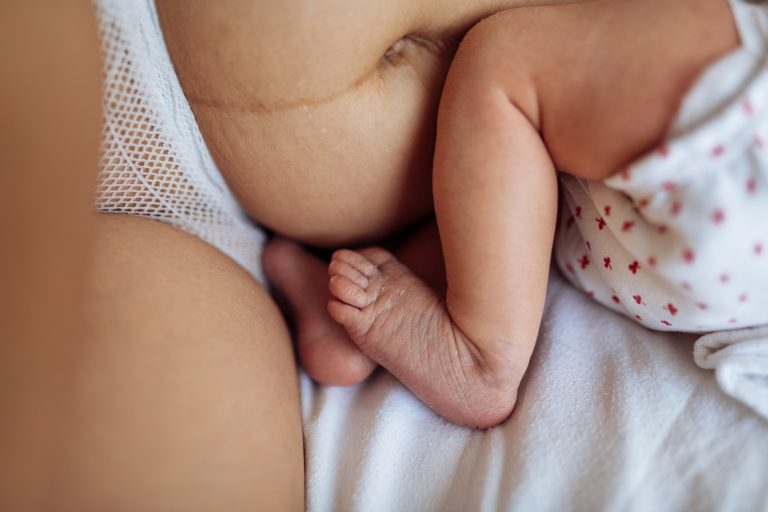Are you looking for a way to nurture the bond that you have with your baby and support their physical and emotional well-being? Kangaroo care is the perfect skin-to-skin contact that can help you achieve all those things!
Either parent or caregiver can do kangaroo care, which is a great thing. This means that it can be a good way for the parent who isn’t breastfeeding to build a bond with the baby. Knowing how to do kangaroo care and all the benefits of skin-to-skin can help you decide if it’s right for your family and how to incorporate kangaroo care into your routine.

Learn more about the expert newborn care delivered at The Mother Baby Center.
What is kangaroo care?
Kangaroo care is a method of skin-on-skin contact with a newborn that can provide many benefits for both the baby and the parent. To do kangaroo care, lay your diapered baby on your bare chest for about an hour or for as long as your baby can tolerate it. While doing this, you can also have a blanket over your baby or have them wear socks and hats to help keep them warm.
Parents with a baby in the neonatal intensive care unit (NICU) should exercise caution when practicing kangaroo care, but healthcare professionals highly recommend it because it offers many skin-to-skin contact benefits. Before starting kangaroo care in the NICU, talk to your baby’s care team for guidance on how to do it, how often you should be doing skin-to-skin with the baby and for how long.
Why kangaroo care works
Midwifery Today states that healthcare professionals in Bogota, Colombia, initially developed kangaroo care in the 1980s to combat the mortality rate of premature babies. Research shows that skin-to-skin contact after birth can help premature babies regulate their body heat and heat rate. This would then allow babies to save their energy to use for growth, such as gaining weight or brain development. Keep reading to learn more about kangaroo care or skin-to-skin benefits.

Explore The Mother Baby Center locations to find care through every stage of pregnancy and delivery.
Benefits of kangaroo care for babies
There are lots of benefits to kangaroo care and reasons why families should consider adding it to their daily routine. Below are some physical and emotional benefits of newborn skin-to-skin contact and how they’re beneficial for babies.
Regulate heartbeat and breathing
Kangaroo care regulates a baby’s heartbeat and breathing by providing a comfortable space and inducing a relaxation stage. When caregivers perform kangaroo care right after birth, it helps babies adjust to their new environment.
Maintain body temperature
The chest is one of the warmest parts of the body because it is closest to the heart, where there is a lot of blood flow. During newborn skin-to-skin, the parent’s body transfers heat to the baby’s body to help maintain their temperature.
Weight gain
Weight gain is another benefit of kangaroo care and is especially beneficial for premature babies. Kangaroo care helps babies conserve their energy and calories due to not having to overwork their bodies for things like maintaining body temperature and increasing a baby’s interest in feeding.

Discover more articles offering guidance for your growing family from The Mother Baby Center blog.
Reduce stress and pain
Kangaroo care helps babies enter a relaxed and calming state due to being in a comfortable and familiar space. Therefore, if parents or caregivers provide kangaroo care after an event like administering vaccine injections, it can help reduce the stress and pain that a baby may experience from the injection.
Supports breastfeeding
If you are looking to exclusively breastfeed, kangaroo care is perfect for helping stimulate a baby’s interest in breastfeeding and your body’s production of breastmilk from the skin-to-skin contact with the baby on the parent’s chest area. A study published in the International Breastfeeding Journal shows that kangaroo care promotes early initiation of breastfeeding.
Improve sleep and quiet time
Because kangaroo care can help a baby be calm and feel safe, this in return can improve their sleep and quiet time when awake. In a study that was done and published in the Journal of Nursing Research, kangaroo care was shown to help premature babies stay in deep sleep and quiet during awake times for longer.
Benefits of kangaroo care for parents
The benefits of kangaroo care go beyond the baby. It is also beneficial for parents. Kangaroo care has been shown to build the bond between parent and baby, increase confidence in parenting, support breastfeeding and milk production, and reduce stress.
- Bonding with baby: Extended kangaroo care can help build an emotional connection between the baby and parent through skin-to-skin contact. The close proximity allows parents to observe their baby’s cues and respond promptly, fostering a sense of confidence in their parenting abilities. This increased confidence can have a ripple effect on other aspects of parenting, leading to a more relaxed and enjoyable experience.
- Increased confidence in parenting: The increased confidence in parenting comes from the stronger bond and emotional connection that parents are building with their baby through kangaroo care. Parents with a strong bond to their baby may find that they are more in tune with their baby’s needs.
- Supports breastfeeding and milk production: Kangaroo care makes it easy for a baby to access their mother’s breast and pique interest in breastfeeding. This is important because breastfeeding results in increased milk production and aids your milk supply the more you can do it.
- Reduce stress: This is a benefit for both the baby and the parent. Reduced stress comes from the relaxing and calming nature of kangaroo care.

Ensure your child’s health with a caring, and experienced physician, and find a provider today.
When to use kangaroo care
Although it was developed for premature babies, kangaroo care is beneficial for all newborns and can be used in a hospital setting or at home. Not to mention, anyone can do kangaroo care with a baby.
It’s recommended that each kangaroo care session lasts at least an hour, but every baby is different and has different needs. Talk to your baby’s care team about how often and how long you should be doing skin-to-skin contact. Kangaroo care can be used in the following example scenarios.
- Immediately after delivery: If possible, it is recommended that kangaroo care be done immediately after birth to help newborns become familiar with their new environment as they will be used to their parent’s scent, heartbeat and warmth. Skin-to-skin after birth can also help with stabilizing a baby’s temperature and heart rate.
- Babies in the NICU: Kangaroo care is incredibly beneficial for babies in the NICU, whether it be because they were born early or have other health concerns.
- Babies in need of breathing support: Kangaroo care can also be beneficial for babies who need breathing support. Skin-to-skin contact can help with regulating a baby’s heart and breathing.
How to do kangaroo care
Before starting kangaroo care, it is important to talk to someone from your baby’s care team about their recommendations and what may be best for your baby. Things like the duration of each session and how to do kangaroo care can be different for a healthy baby versus a baby in the NICU.
Below are some basic steps of what kangaroo care involves to help your family get started or familiarized with the idea.
- Find time: Generally, each kangaroo care session should last for an hour or two to get the most benefits of holding your baby. Blocking time off to do this where you won’t be disrupted is important.
- Dress comfortably: Wear something that will make it easy for you to open the front. At the hospital, this can be your hospital gown, and at home, you can wear a shirt that opens at the front or a zip-up hoodie. If you are looking to breastfeed, not wearing your bra will give your baby easy access to your breasts and increase their interest in breastfeeding.
- Place your baby on your chest: Your baby should be placed in an upright position where their head is resting on your chest. During kangaroo care, your baby should also not be wearing clothes for skin-to-skin contact. However, they can still wear a diaper, hat, gloves and socks to help keep them warm. You can also place a blanket over your baby as well.
- Relax and enjoy: Kangaroo care is a time for both the parent and baby to rest and relax. It is not uncommon for your baby to fall asleep during a session.
Kangaroo care for babies with breathing tube
If your baby has a breathing tube, it is important to get the help of a nurse. They should be the ones moving your baby and helping you adjust because anytime a baby moves, there is a chance that their breathing tube may also move.
Having a nurse help means they can help adjust the breathing tube as needed and prevent any breathing problems. While doing kangaroo care with a baby with a breathing tube, make sure to stay close to a call light if you need help moving, and keep in mind that it is not uncommon for your baby’s nurse to check in often on the breathing tube.
Holistic and expert care delivered at The Mother Baby Center
Kangaroo care is a special method of skin-to-skin contact with your baby that can support their physical and emotional well-being. Research has proven that skin-to-skin contact provides many benefits for both the parent and baby. Some example benefits are building a bond, increased confidence in parenting, interest in breastfeeding, weight gain for the baby, reduced stress and improved sleep.
If you are considering doing kangaroo care, it is important to know the basic steps of how to do it and talk to your baby’s care team for their recommendations as every baby will have different needs.
At The Mother Baby Center, we are ready to help guide families every step of the way, whether it be through pregnancy or kangaroo care. Find a provider that would best fit your family’s needs and check out other services that we offer after your baby is born.